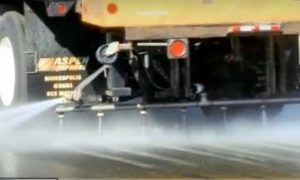 Liquid materials are used for both anti-icing and deicing applications. Liquids have many benefits: They begin to work immediately, effectively stay on the roadway, and use less chloride than granular salt, which leads to cost savings and reduced environmental impact. After evaluating liquids in several studies, Clear Roads created two training videos to help state DOTs accelerate the implementation of liquid-only plow routes.
Liquid materials are used for both anti-icing and deicing applications. Liquids have many benefits: They begin to work immediately, effectively stay on the roadway, and use less chloride than granular salt, which leads to cost savings and reduced environmental impact. After evaluating liquids in several studies, Clear Roads created two training videos to help state DOTs accelerate the implementation of liquid-only plow routes.
Related research topics:
Specifications and Guidance
- Clear Roads Application Rate Guidance for Salt Brine Blends for Direct Liquid Application and Anti-Icing
- Clear Roads Liquid Roadway Treatments Technical Reference Guide
- Clear Roads Liquid Roadway Treatments Start-Up Reference Guide
- Clear Roads Material Application Methodologies Guidebook
Videos
Implementation of Liquid-Only Plow Routes (Full Video)
Implementation of Liquid-Only Plow Routes (Short Video)
Other Research and Resources
- Evaluation of Winter Maintenance with Salt Brine Applications in Wisconsin (Wisconsin DOT, 2021)
- Corn-Based Deicers (Iowa DOT, 2020)
- Estimating the Application Rate for Liquid Chloride Products Based on Residual Salt Concentration on Pavement: Researchers used laboratory testing to evaluate how much salt brine (as chloride) remained on asphalt vs. concrete pavement after simulated traffic and plowing. (Western Transportation Institute, 2018)
- Evaluation and Analysis of Liquid Deicers for Winter Maintenance: This project reviewed the performance of eight liquid deicers in the field and lab. (Ohio DOT, 2017)
- Salt Brine Blending to Optimize Deicing and Anti-Icing Performance and Cost Effectiveness: Phase III (Minnesota DOT, 2017)
- Guidelines to Facilitate the Evaluation of Brines for Winter Roadway Maintenance Operations (Texas DOT, 2017)
- Snow and Ice Practices (Ohio DOT, 2011)
